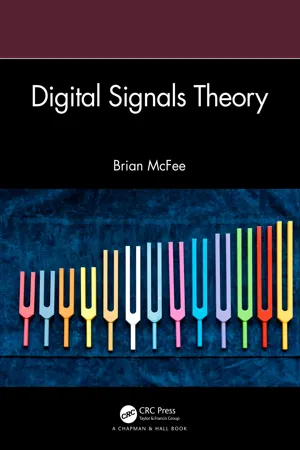
- 274 pages
- English
- ePUB (mobile friendly)
- Available on iOS & Android
Digital Signals Theory
About this book
Where most introductory texts to the field of digital signal processing assume a degree of technical knowledge, this class-tested textbook provides a comprehensive introduction to the fundamentals of digital signal processing in a way that is accessible to all.
Beginning from the first principles, readers will learn how signals are acquired, represented, analyzed and transformed by digital computers. Specific attention is given to digital sampling, discrete Fourier analysis and linear filtering in the time and frequency domains. All concepts are introduced practically and theoretically, combining intuitive illustrations, mathematical derivations and software implementations written in the Python programming language. Practical exercises are included at the end of each chapter to test reader knowledge.
Written in a clear and accessible style, Digital Signals Theory is particularly aimed at students and general readers interested in audio and digital signal processing, but who may not have extensive mathematical or engineering training.
Frequently asked questions
- Essential is ideal for learners and professionals who enjoy exploring a wide range of subjects. Access the Essential Library with 800,000+ trusted titles and best-sellers across business, personal growth, and the humanities. Includes unlimited reading time and Standard Read Aloud voice.
- Complete: Perfect for advanced learners and researchers needing full, unrestricted access. Unlock 1.4M+ books across hundreds of subjects, including academic and specialized titles. The Complete Plan also includes advanced features like Premium Read Aloud and Research Assistant.
Please note we cannot support devices running on iOS 13 and Android 7 or earlier. Learn more about using the app.
Information
Table of contents
- Cover Page
- Half-Title Page
- Title Page
- Copyright Page
- Dedication Page
- Contents
- Preface
- Chapter 1 ◾ Signals
- Chapter 2 ◾ Digital sampling
- Chapter 3 ◾ Convolution
- Chapter 4 ◾ Complex numbers
- Chapter 5 ◾ The discrete Fourier transform
- Chapter 6 ◾ Properties of the DFT
- Chapter 7 ◾ DFT invertibility
- Chapter 8 ◾ Fast Fourier transform
- Chapter 9 ◾ The short-time Fourier transform
- Chapter 10 ◾ Frequency domain convolution
- Chapter 11 ◾ Infinite impulse response filters
- Chapter 12 ◾ Analyzing IIR filters
- Appendix A Mathematical fundamentals
- Bibliography
- Index